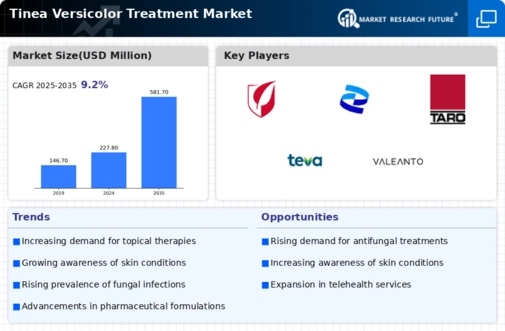Tinea Versicolor Treatment Size
Tinea Versicolor Treatment Market Growth Projections and Opportunities
The dynamics and growth of market are influenced by many factors. Tinea versicolor is a common fungal infection of the skin that has led to an increased demand for effective treatments leading to its expansion. A notable cause of the industry’s expansion is an increase in tinea versicolor infections all over the globe. As awareness about this condition increases, more individuals seek medical attention, creating a growing patient pool.
In addition, medical research and technology advancement are essential in driving the Tinea Versicolor Treatment Market. The market is further shaped by on-going efforts to develop innovative and more efficacious treatment options. Pharmaceutical firms spend heavily in the development of novel therapeutic solutions through Research & Development (R&D) which improve patient outcomes and satisfaction. Consequently, there is continuous innovation that causes competition among players in the market as they strive to improve existing treatments or create new ones that will eventually be used by patients therefore promoting growth.
Furthermore, Tinea Versicolor Treatment Market is significantly determined by regulatory landscape. Before any new drug enters market there will have been a need for very strict regulatory approvals that confirm their safety and efficiency. Regulatory bodies form standards and guidelines that companies are supposed to meet thereby affecting general market dynamics. The whole process of gaining regulatory approval can be very time consuming as well as expensive thus impeding entrance of new products into markets; therefore, any change on policies could result into altering marketing trends shaping it both for established and emerging players.
Economic conditions related market factors play a critical role in dictating how Tinea Versicolor Treatment Market moves forward Evidently for patients or healthcare givers with cost being considered as one major factor. Economic changes directly impact healthcare spending therefore insurance coverages affects directly or even adoption of certain drugs occurs at specific times only due to cost variables connected with them For instance, income levels can influence preference for health care services while cultural beliefs also affect use of particular medications.Economic recessions highly contribute towards low affordability of healthcare facilities within a given society.
Global demographic trends contribute significantly to the market dynamics of tinea versicolor treatment. Aging population worldwide results in increased chances of having skin conditions such as tinea versicolor. This segment often has specific treatment needs which drive the market players to look into them and this can be seen as an opportunity on their part. On the other hand, there are young people who also use services because they want to enhance their beauty which causes demand for better treatment options.
Further technological advancement in diagnostic tools and techniques impact Tinea Versicolor Treatment Market by facilitating accurate and timely diagnosis. Advanced diagnostic capabilities ensure early detection of tinea versicolor that facilitates immediate onset of treatment. The patient’s outcome is determined by these factors and it also affects the prescription choice made by healthcare professionals. It is expected that going forward, there will be increasing role in determining the shape of market landscape for diagnosing technologies.









Leave a Comment